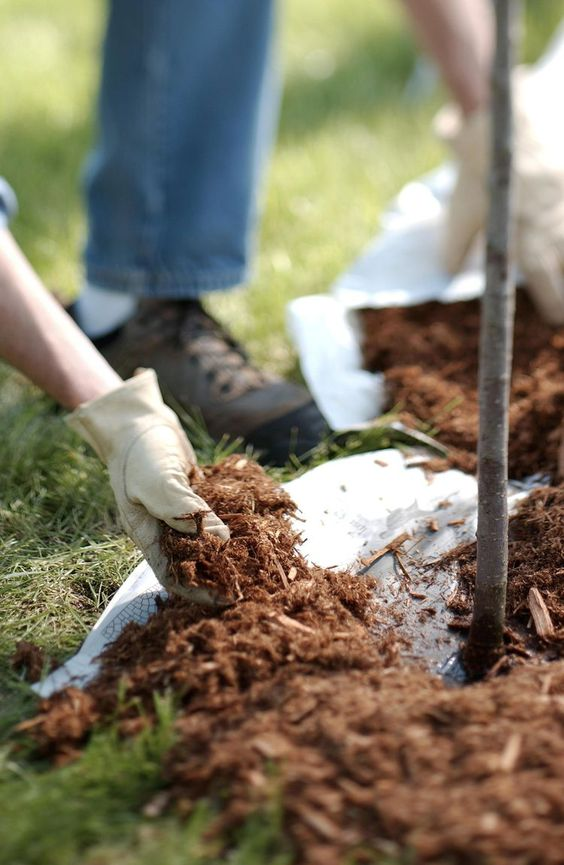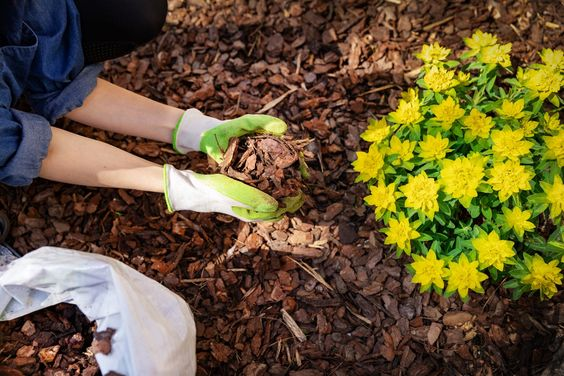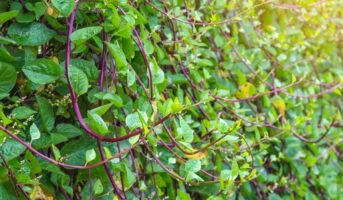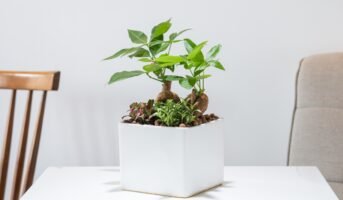Mulching: What is mulching?
Looking for mulching meaning or mulching definition? A mulch is a layer of material that is applied to the soil’s surface. Mulch is used for several purposes, such as preserving soil moisture, enhancing soil fertility and health, controlling weeds, and adding aesthetic value. Mulch is typically, but not always, organic in nature.
Mulching is one of the most straightforward and advantageous gardening techniques. Mulch can be defined as a protective layer of material spread on top of the soil. Mulches can be organic (grass clippings, straw, bark chips, and other similar materials) or inorganic (stones, brick chips, and plastic). Mulches, both organic and inorganic, have numerous advantages.
See also: The many properties of soil
Mulching: What are the different types of mulching?
Mulching is classified into two types.
- Mulching with organic materials
- Mulching with plastic
Mulching with organic materials
Organic mulches improve the soil’s condition. These mulches supply organic matter to keep the soil flexible as they break down over time. This encourages root development, improves water infiltration, and raises the soil’s capacity to hold water. Organic matter gives plants the nutrients they need and creates the perfect environment for earthworms and other helpful soil creatures.
Mulch can be made from the following materials:
- Dry leaves, weeds, and flowering plant remnants
- Crop byproducts
- Husks of corn
- Straw made from wheat
- Straw made from rice
- Peeled sugarcane
- Wood shavings (wood chip)
- Cut back and use as mulch after pruning mango and other orchards.
- Food for animals

Source: Pinterest
Peat moss
Peat moss or sphagnum peat is widely used as a mulch as it is long lasting and packaged. When wetted and dried, peat moss can form a dense crust that prevents water to soak in. When dry it can also burn, producing a smouldering fire. Sometimes, it is mixed with pine needles to create a mulch that is friable. It can also lower the pH of the soil surface, which is beneficial as a mulch under acid loving plants.
Mulching with plastic
Under the plant canopy, a black or dark plastic sheet is spread. It is rarely successful in gardens because the ground beneath the mulch warms up in extreme heat.
Mineral or ornamental mulch
Mineral mulch is non-biodegradable and known to have a longer lifespan. One can use crushed stones, slate, shredded wood, clay pellets, colourful pebbles, sand, gravel, peat moss, etc. These materials provide mulch while serving as a decorative ground cover and keeping the soil warm.
Mulching: Method of mulching
- Create a bed 12 inches high, 8 to 10 feet below the huge mango plant’s canopy, and mulch it with the mulching material on hand. Making a bed serves the function of preventing irrigation or precipitation from remaining along the plant’s trunk. That will probably change in the future.
- Mulching can range from 1 to 12 inches in thickness.
- Weeds and grasses are best covered with dense mulching.
- Mulching can be done in hot or cold weather.
- If you mulch during the rainy season, you risk fungus growth due to moisture.

Source: Pinterest
Mulching: Ways to mulch on your property
Mulch can be used in 3 different ways on your property:
- Mulching your garden
- Mulching trees and shrubs
- Mulching lawns
Mulching your garden
- Mulching the garden will greatly improve your harvest if you follow a few simple rules.
- For starters, most seeds cannot be sown in mulch.
- This means you’ll need to either wait until you’re finished sowing seeds before mulching or move the mulch aside. Mulching will not be an issue as long as you are cautious.
- Mulch is excellent for insulating the ground (and your plants!) against cold weather. This makes perennial overwintering vegetables and managing a winter garden easier.
- On the other hand, mulch may prevent your soil from warming up as quickly as in the spring. As a result, you may want to wait until your garden soil warms up before adding mulch. Just make sure to apply the mulch before the rain stops.
- It will reduce the amount of water you need to use and will also help keep weeds at bay.
- Mulching mimics nature’s tried-and-true system for enriching soils and fostering abundance that has been in place for millennia. Your garden will appreciate it.
Mulching trees and shrubs
- This is a no-brainer in many ways. Mulch will assist in lowering the requirement for watering, improving the soil, and suppressing undesirable weeds that would compete with the trees and shrubs for resources. And, unlike when planting seeds, you don’t have to be as concerned with leaving space for a delicate new seedling to emerge.
- However, mulch has another incredible and surprising benefit for shrubs and trees: fungi.
- Trees and shrubs are designed to grow in soil that is rich in fungi, but our degraded soils frequently lack these vital participants.
- Fungi assist plants by connecting with their roots and providing water, nutrients, and minerals that the plants may not be able to obtain on their own. Fungi, in essence, become an extension of the plant’s roots.
- Fungi even allow plants to share nutrients with one another!
- Mulching around your trees and shrubs creates the environment that fungi require, which benefits your plants.
Mulching lawns
- Leaving grass trimmings on the lawn after mowing is the simplest way to do this. Do not bag them; merely allow them to rot.
- The grass clippings will feed soil life and build soil, which will fertilise your lawn and reduce the amount of water you need to provide it.
- If you’re concerned about grass clippings on the surface, a mulching lawn mower is an easy solution.
- To give your lawn an annual boost, you may also do this with any leaves that land on your property. Simply cut up the leaves with your lawnmower so they decompose rapidly to assist the soil in nourishing your grass. This is far more convenient than raking up all those leaves!
Mulching: Advantages
- The fundamental advantage of using organic mulch, like wood chips, is that it feeds soil life, which improves soil quality and nourishes plants. This kind of mulching works with nature to promote long-term abundance for humans, plants, and wildlife.
- Mulching with organic materials enriches your soils with organic matter. This not only sustains soil life but also aids in water retention so that the soil does not become soggy. Mulch also reduces evaporation, which helps your garden retain water.
- You must start mulching if you want to convert your garden to a low-water garden. Mulching has the advantage of reducing the amount of water your plants require.
- While your plants are growing, mulching can help keep weeds at bay and so save you (and your plants) time and energy.
- When paired with newspaper, cardboard, or burlap sacks, sheet-mulching—a type of mulching—is a terrific technique to prepare soil for planting (all of which will break down into soil). It can suffocate undesirable plants while also laying the groundwork for your future planting efforts to succeed.
- Mulching enables to retain moisture in the soil. Thus, lesser amount of water is needed during irrigation. Mulch directly traps surface water of the soil, preventing it from evaporating quickly and conserving water.
- Mulching regulated soil temperature, which promotes root growth.
- It helps in protecting the soil from erosion, heavy winds, intense sunlight and overall weathering.
Mulching: Disadvantages
- Because mulching creates the ideal environment for pests like slugs and pill bugs, it may lead to a rise in their population. This is less of an issue with wood chips, but it can be with fall leaves, straw, or hay. This, however, is not a permanent disadvantage of mulching. Over time, the number of predators that devour those pests will rise, creating a new equilibrium.
- The time, effort, and potential cost associated with acquiring the material are the main drawbacks of mulching.
- All of this takes time and effort. Mulch benefits will save you time and energy in the long run, but you must get past the initial investment.
- Another potential disadvantage is the introduction of contaminated materials—materials with pesticide or herbicide residue or other chemical residues. Straw and animal manure are the most prone to this problem. In general, wood chips are safe.
- Since straws have the potential to cause issues, avoid using mulch from diseased plants simply to be careful. Diseases are typically not disseminated through the mulch.
- It is also more difficult to direct seed your garden when it is heavily mulched. To plant the seed in the soil rather than the mulch, you will need to draw back the mulch.
- Light rain or irrigation may only moisten the mulch’s top layer, not the soil below. However, this is only a problem after a prolonged drought or when using overhead sprinklers. Watering a mulched garden with drip hoses is an effective and efficient method.
Where can you mulch?
Mulching technique can be applied anywhere in the garden, including potted plants, orchards, and hedges.
When should you mulch?
Mulching can be done anytime and throughout the year. However, one should lighten the mulch layer in the spring, while you can spread mulch on the moist soil during summers and cover the soil with mulch after loosening it during winter.
How much mulch is required?
One can use a layer of two to three inches of organic mulches. The finer the material, the thinner the layer required. However, inorganic mulches are often shallower. A mulch of small stones usually only needs to be an inch deep.
FAQs
How deep should you lay the mulch?
The type of mulch you use is determined by the type of plant you want to grow. For a vegetable garden, for example, you should spread at least 3 inches of mulch around each plant. If you want to grow flowers, spread 2 to 4 inches of mulch around them.
What happens when bark is used as mulch?
Bark contains a lot of lignin, which helps to hold soil particles together. It also contains tannins, saponins, and resins, which aid in the prevention of weed growth through the mulch.
When is the ideal time of year to use bark as mulch?
Mulch is best applied during the dormant season. This will give the mulch enough time to decompose by late spring.
Housing News Desk is the news desk of leading online real estate portal, Housing.com. Housing News Desk focuses on a variety of topics such as real estate laws, taxes, current news, property trends, home loans, rentals, décor, green homes, home improvement, etc. The main objective of the news desk, is to cover the real estate sector from the perspective of providing information that is useful to the end-user.
Facebook: https://www.facebook.com/housing.com/
Twitter: https://twitter.com/Housing
Email: editor@housing.com











